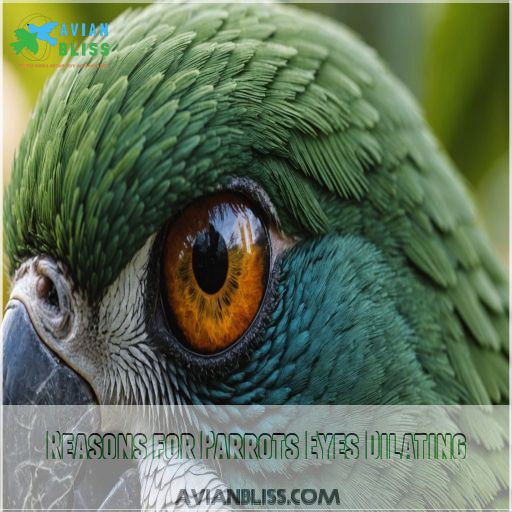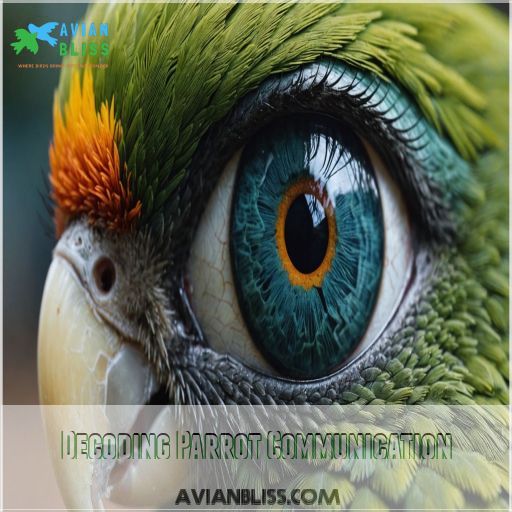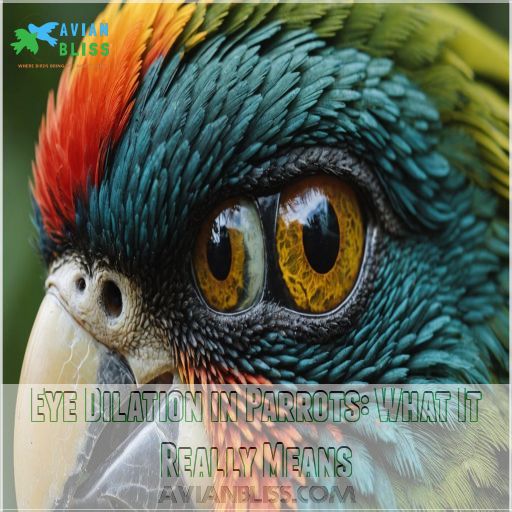This site is supported by our readers. We may earn a commission, at no cost to you, if you purchase through links.
 When you notice your parrot’s eyes dilating, it’s like getting an all-access pass to their emotions. This eye-popping act, known as "eye pinning," shows excitement, curiosity, or even irritation.
When you notice your parrot’s eyes dilating, it’s like getting an all-access pass to their emotions. This eye-popping act, known as "eye pinning," shows excitement, curiosity, or even irritation.
Just like how you might widen your eyes at a surprise party, your parrot could be thrilled with a new toy or curious about a visitor. Sometimes, though, it signals stress or fear if their world gets too chaotic.
To keep your feathered friend happy, watch their eyes along with other body language clues. Dive deeper into these behaviors, and soon you’ll speak fluent "parrot".
Who knew decoding bird language could be so chirpy?
Table Of Contents
- Key Takeaways
- What is Eye Pinning
- Reasons for Parrots Eyes Dilating
- Eye Dilation and Parrot Emotions
- Decoding Parrot Communication
- Why Do Parrots Eyes Dilate When Talking
- Managing Parrot Eye Dilation
- Eye Dilation in Parrots: What It Really Means
- Frequently Asked Questions (FAQs)
- What does it mean when a parrots pupils are dilated?
- Do birds’ pupils dilate when happy?
- Why are my parrots pupils so big?
- What does it mean when a bird’s eyes are pinning?
- Can stress cause a parrots eyes to dilate?
- How is eye dilation linked to parrot health concerns?
- Are there medical conditions affecting eye dilation in parrots?
- Can eye dilation indicate a parrot is uncomfortable?
- Is eye dilation in parrots ever a serious issue?
- Conclusion
Key Takeaways
- Keep an eye on your parrot’s pupils—dilated eyes often mean they’re excited, curious, or even cranky. It’s like their version of an emoji, showing you what they’re feeling without saying a word.
- Eye pinning isn’t all drama; a parrot’s pupil dance can signal happiness, especially during chats or when they’re eyeing their favorite toy—it’s their way of saying, "I’m into this!"
- Stress and discomfort can cause those pupils to expand too. If your bird’s eyes look like they’re ready to pop, it might be time to create a chill zone and avoid those pesky stress triggers.
- Not just mood indicators, eye changes can also flag health concerns. If the pupils dilate suddenly or seem off, a trip to the vet might just save your parrot from bigger eye troubles.
What is Eye Pinning
Ever caught your parrot’s pupils playing peek-a-boo? That rapid dilating and constricting, known as eye pinning, is their quirky way of chatting without a single squawk.
Definition of Eye Pinning in Parrots
Ever notice your parrot’s eyes suddenly shrinking to pinpoints?
This is called "eye pinning" – an involuntary response to stimuli, from excitement to annoyance.
It’s a window into your feathered friend’s emotional state.
So keep an eye out for those dilated pupils – they’re telling you something about their emotional state, an indicator of their mood, and that is a key aspect of emotional state.
How Eye Pinning Works as a Form of Communication
Imagine a parrot’s eyes dancing like disco lights—they’re not just having a party!
Eye pinning, or the rapid dilation and constriction of their pupils, is a flashy form of bird language.
It signals their emotions, from curiosity and excitement to irritation.
When you observe this flickering, it’s your cue to decode their feelings and understand their squawk-talking.
Importance of Eye Pinning in Bird Behavior
You’re already clued into how parrots communicate, but have you noticed their eye pinning?
It’s like a neon sign flashing emotions. The rapid dilation and constriction are bird language in action.
This eye pinning signals excitement, curiosity, or annoyance, essential for figuring out a bird’s health and understanding its mood in various situations, especially when considering potential aerosol poisoning symptoms
.
Remember, context is everything!
Reasons for Parrots Eyes Dilating
You’re probably wondering why your parrot’s eyes suddenly widen and narrow like a car’s headlights.
From expressing emotions like excitement or fear to signaling communication and reacting to their surroundings, those little eye movements are their way of talking to you.
Minus the squawking, those little eye movements are their way of communicating with you.
Emotional State and Eye Dilation
A parrot’s eyes can tell a colorful tale.
When they’re excited or stressed, you’ll notice their pupils dilate. It’s like their eyes are shouting, "Hey, pay attention!"
This eye dilation acts as a communication cue reflecting their emotional state. By observing these changes in pupil size, you can better understand your bird’s behavior and needs—quite the eye-opener.
Communication Patterns in Parrots and Eye Dilation
Parrot communication is as colorful as their feathers.
Eye pinning, where pupils rapidly change size, is more than a magic trick—it’s part of their chat!
Excitement, curiosity, or even a peck of annoyance can be seen through their eyes.
Decoding this with body language and context clues turns you into a parrot whisperer extraordinaire, understanding their eye pinning like never before.
Environmental Factors Affecting Eye Dilation
With shifting light intensity, a parrot’s eyes might dilate like a theater curtain rising, ready for a show. Noise levels, like a sudden drumroll, can also trigger pupil reactions.
Don’t overlook temperature changes; they’re like nature’s unpredictable pranksters. Plus, a lively social interaction or the sight of food availability can expand pupils faster than you’d think.
Just like ostriches with their massive eyes, parrots have evolved to adapt to their environment, and their eye dilation is a key part of that.
Eye Dilation and Parrot Emotions
Ever wonder why your parrot’s eyes seem to pop in and out like a jack-in-the-box?
It turns out those rapid pupil changes are a window to your parrot’s emotional state, revealing feelings such as curiosity to fear and everything in between.
Curiosity and Interest in Eye Dilation
Imagine spotting your parrot’s dilated pupils while they eye a new toy—it’s like a detective uncovering a mystery!
These curiosity cues signal four things:
- Eye pinning: A dance of excitement.
- Bird behavior: An engaging play.
- Interest signals: A feathered focus.
- Dilated pupils: A peek into a parrot’s mind.
Fascinating, right?(Source)
Fear and Anger in Parrots and Eye Dilation
Ever notice your parrot’s pupils suddenly dilate when they’re upset? It’s like their eyes say, "Warning: I’m not in the mood!"
These dilations are powerful signals of fear or anger—aggression cues not to be ignored.
When paired with other behaviors like growling or feather fluffing, it’s best to use calming techniques and give them space.
Happiness and Excitement in Eye Dilation
A parrot’s eyes might flash like a disco ball when it’s thrilled.
This playful dilation, known as eye pinning, signals excitement from happy birds and excited parrots during playtime or when they’re about to hear their favorite tune.
Expect happy squawks accompanying these eye movements, as your feathered friend expresses pure delight in their unique way.
Decoding Parrot Communication
When your parrot’s eyes start flashing like a disco ball, it’s more than just a light show—it’s part of how they communicate with you.
By watching their eye movements and body language, you can pick up on what they’re feeling and saying.
Observing Eye Pinning and Body Language
Spotting those rapid eye pinning cues in your parrot can be like reading an open book of emotions.
A quick pupil dance might say, "I’m curious!" or scream, "I’m furious!"
Decode these body language signals by pairing them with other behavior patterns, like checking out signs of boredom or obsession
.
Just remember, your feathered friend’s wide-eyed gaze isn’t always love at first sight!
Identifying Patterns in Parrot Behavior
You’ve marveled at eye pinning and body language, now let’s crack open their world by identifying patterns in parrot behavior.
Listen closely to bird calls like a secret code.
Observe feather ruffling and beak grinding for hidden clues.
Pay attention to head bobbing and wing flapping that reflect emotions and desires, turning you into a parrot-whisperer extraordinaire! (Source)
Adjusting to Light and Environmental Stimuli
Parrots’ eyes can dilate dramatically, adjusting to changes in light and environmental stimuli.
This pupil reflex allows them to see better in low light for improved night vision, similar to birds with exceptional nocturnal adaptations
.
Yet, prolonged sun exposure can cause their pupils to constrict, protecting sensitive eyes from glare.
Understanding these adaptations can help you decode a parrot’s mood and communication.
Why Do Parrots Eyes Dilate When Talking
When your parrot starts chatting away, you might notice its eyes dilate, like they’re getting excited about the conversation.
This eye action isn’t just random; it’s a fascinating part of how they express their emotions and connect with you during their birdie banter.
Relationship Between Eye Dilation and Communication
Imagine your parrot flashing its eyes during a chat—it’s like turning on a vibrant neon sign saying, "I’m engaged!"
Eye pinning showcases their emotions, reflecting excitement or curiosity, which are key communication cues.
Understanding this bird language helps you grasp parrot behavior better, like decoding a mysterious, feathery puzzle waiting to be solved, through decoding a mysterious, feathery puzzle understanding their body language
.
Why Eye Dilation Occurs During Speech in Parrots
Did you know when a parrot chatters, their eyes dilate due to excitement? This phenomenon highlights communication and pupil size changes as they vocalize. Parrots use this swelling to show engagement during conversation.
- Eye dilation signals interest or enthusiasm.
- Indicates playful or curious behavior.
- Shows nonverbal communication skills.
- Reflects emotional states.
- Enhances bonding moments.
Differences in Eye Dilation Across Parrot Species
You might notice your parrot’s eyes darting all around, revealing a world of species-specific eye dilation. Some parrots showcase bold dilation variations, while others prefer subtle eye pinning traits.
For instance, a parrot may puff up to appear larger and more intimidating to potential threats, which could be linked to changes in their eye behavior. They may also puff up to express happiness and excitement, which can be reflected in their eye dilation patterns and overall body language, such as during anticipation of treats or petting, a behavior often referred to as parrot puffing up.
Cockatoos, for instance, might widen their irises during breeding displays, flashing those eyes like headlights. Understanding these differences helps decode their chatter and builds a better bridge between you and your feathered friend.
Managing Parrot Eye Dilation
Managing your parrot’s eye dilation might seem like taming a tiny feathered drama queen, but it’s really about offering a calm, safe space where they feel secure.
By reducing stress and providing comfort, you can help your parrot express itself in a healthy way without the dramatic eye flair.
Providing a Calm and Safe Environment
When parrots engage in conversation, their eyes might dilate, reflecting excitement or curiosity.
To help your feathered friend stay calm, create safe spaces with thoughtful perch placement and noise control.
Stock up on bird-safe toys for enrichment, and maintain routine consistency.
It’s like setting the stage for a peaceful play, keeping their minds engaged and their eyes content.
Avoiding Aggravation and Stress
Parrots thrive in a stress-free environment. Provide safe spaces with minimal distractions and quiet time for your feathered friend.
Approach them calmly and avoid sudden movements that could trigger eye dilation from fear or aggravation.
Positive interaction and gentle handling go a long way in keeping your parrot relaxed and content.
Offering Comfort and Reassurance
After minimizing stress, offering comfort and reassurance to your parrot becomes as easy as pie.
Create a calm environment with a safe space where gentle handling and positive interaction reign supreme.
Picture comforting a nervous friend. Birds, like humans, need that reassuring vibe to thrive.
A little empathy goes a long way in reducing stress and eye dilation.
Eye Dilation in Parrots: What It Really Means
You might be wondering why your parrot’s eyes seem to dilate at the most unexpected times.
It’s not just random; these eye movements are their way of telling you how they feel, whether they’re thrilled, curious, or maybe just a bit grumpy.
These eye movements are their way of telling you how they feel, whether they’re thrilled, curious, or maybe just a bit grumpy.
Interpreting Dilated Pupils in Parrots
You’ve managed your parrot’s environment, ensuring calm vibes, but understanding those dilated pupils takes it up a notch. Eye pinning is like reading a secret code. It signals emotions, from curiosity to stress.
Here’s how to interpret them:
- Excitement: Pupils widen when thrilled.
- Fear: Rapid dilation signals danger.
- Aggression: Accompanied by tail fanning.
Common Misconceptions About Eye Dilation
Spotting a parrot’s eye dilation can be as mystifying as magic tricks.
Many assume it always signals aggression, but don’t jump to conclusions.
Eye dilation can also indicate curiosity or excitement.
Misinterpretations lead to unnecessary worries about health issues or behaviors being out of whack.
Understanding the nuances, like eye pinning, helps avoid these common blunders.
Importance of Observing Eye Dilation in Parrot Behavior
Consider eye dilation as your parrot’s way of telegraphing its mood swings, a feathery Morse code of sorts.
Whether it’s excitement or a subtle warning sign, understanding these cues helps in training and health check-ups.
Different species and ages exhibit varying patterns, making observation key.
Next time, don’t blink—your parrot’s pupils might reveal secrets, through its mood swings.
Frequently Asked Questions (FAQs)
What does it mean when a parrots pupils are dilated?
Imagine your parrot’s eyes dilating wildly; it’s a sign of excitement, fear, or aggression.
This eye-pinning behavior shows they’re reacting strongly to something, like a treat, a toy, or even warning you of potential danger.
This reaction could be triggered by various stimuli, but the key is understanding what sparks it, whether it be a treat or something else entirely.
Do birds’ pupils dilate when happy?
Birds’ pupils can dilate when they’re happy or excited.
This behavior, known as "eye pinning," indicates excitement or interest.
It’s a sign they’re uber-excited, like when you’re giddy over the last cookie.
Why are my parrots pupils so big?
They say eyes are windows to the soul.
Your parrot’s big pupils could mean excitement, curiosity, or even fear.
Pay attention to body language and sounds to understand if they’re happy, upset, or just curious.
What does it mean when a bird’s eyes are pinning?
Eye pinning in birds is a rapid pupil change, indicating excitement, curiosity, or aggression.
When your bird’s eyes pin, it’s sharing its mood with you, whether overjoyed for a treat or uneasy about something new.
Can stress cause a parrots eyes to dilate?
Stress can indeed cause a parrot’s eyes to dilate, along with rapid pupil changes and other behaviors like lunging or panting.
Recognizing these signs helps you understand when your feathered friend might need some extra care, especially for the sake of their extra care .
How is eye dilation linked to parrot health concerns?
Dilated pupils in parrots can signal eye issues like cataracts, glaucoma, or retinal detachment. Get your feathered friend checked out by an avian vet right away if you notice this sign of illness
. (Source)
Are there medical conditions affecting eye dilation in parrots?
Parrots’ eye dilation can signal health issues. Conditions like conjunctivitis or glaucoma impact this, causing signs like redness or discharge.
If your parrot shows unusual eye behavior, visit a vet for peace of mind and proper care.
Can eye dilation indicate a parrot is uncomfortable?
Your parrot’s eye dilation might signal discomfort or stress.
Birds in distress can show increased head movements and other stress signs.
If you spot this, creating a calming environment could help ease their anxiety.
Is eye dilation in parrots ever a serious issue?
Imagine your parrot’s eyes as mood rings; they can reveal excitement or stress.
But if the eyes change suddenly or show signs like swelling or redness, it could signal a health issue needing a vet’s attention.
Conclusion
Spotting your parrot’s eyes dilate is like catching a glimpse into their world, revealing secrets only they can share.
When you wonder, "why do parrots’ eyes dilate," it often points to their emotions and environment.
By tuning into this subtle signal, you’ll better grasp their joys and jitters.
This eye opener helps you forge deeper connections, ensuring your parrot feels both heard and secure.
Understand eye dilation, and you’ll speak the language of parrot like a pro.










